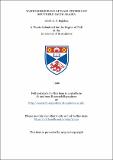Files in this item
Water resources of wadi systems of Southern Saudi Arabia
Item metadata
| dc.contributor.advisor | McManus, John | |
| dc.contributor.advisor | Duck, Rob | |
| dc.contributor.author | Bajabaa, Saleh A. S. | |
| dc.coverage.spatial | 666 p. | en_US |
| dc.date.accessioned | 2018-07-10T16:31:10Z | |
| dc.date.available | 2018-07-10T16:31:10Z | |
| dc.date.issued | 1996 | |
| dc.identifier.uri | https://hdl.handle.net/10023/15212 | |
| dc.description.abstract | This study is a water resources assessment of two wadi systems in the southern Arabian Shield using seismic refraction, electrical resistivity (VES) and borehole geophysical techniques, pumping tests and ground water quality data and an examination of artificial recharge. Wadi Baysh (flowing southwest to the Red Sea) and Wadi Habawnah (flowing east to the Rub Al Khali) have similar catchment areas (approximately 10000 km2) and are underlain by igneous and metamorphic rocks but contrast in their hydrological cycles. The mean annual rainfall of Wadi Baysh is 350 mm while Wadi Habawnah receives 150 mm. The mean annual water discharges of Wadi Baysh and Wadi Habawnah are 75 and 10 mcm respectively. Hydrochemical classification, evolution of groundwater and its suitability for agricultural and domestic usage were studied in both wadis. In the upper and middle parts of both wadis the solute concentrations reach 1200 mg/l whereas in the lower parts solute concentrations range between 2000 and 3500 mg/l. Both wadis show high average values of transmissivity and storativity determined from pumping tests and grain size analysis. The geophysical surveys confirmed that the unconfined aquifer thickness is less than 42 m in both wadis. The seismic velocities of the aquifers range between 536 and 1817 ms-1 while the resistivities range between 23 and 125 ohm-m in both wadis. The igneous and metamorphic bedrock resistivity range between 3400 and 10260 ohm-m. The sediment has a high potential for water supply in the middle and lower parts of both wadis. The transverse resistance of the saturated part of the aquifers is used for correlation with the hydraulic transmissivity in which a computed empirical function may be applicable to similar aquifers in other Arabian Shield wadis. This study introduces a plan for the surface and subsurface storage that should help to manage the perennial yield and minimise the mining yield. The analysis reveals that building small reservoirs in both wadis is economically justifiable. | en_US |
| dc.language.iso | en | en_US |
| dc.publisher | University of St Andrews | |
| dc.subject.lcc | GB1159.S2B2 | en |
| dc.subject.lcsh | Hydrology | en |
| dc.title | Water resources of wadi systems of Southern Saudi Arabia | en_US |
| dc.type | Thesis | en_US |
| dc.contributor.sponsor | King Abdulaziz University (Saudi Arabia). | en_US |
| dc.type.qualificationlevel | Doctoral | en_US |
| dc.type.qualificationname | PhD Doctor of Philosophy | en_US |
| dc.publisher.institution | The University of St Andrews | en_US |
This item appears in the following Collection(s)
Items in the St Andrews Research Repository are protected by copyright, with all rights reserved, unless otherwise indicated.

